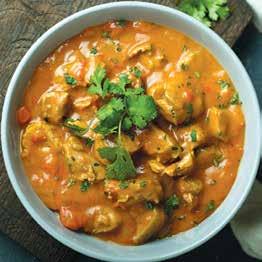
4 minute read
Converting Food to Energy
Learning How Metabolism Works
by Linda Sechrist
Metabolism is the process by which the foods and drinks we consume are converted into energy. We may not notice the cellular mechanisms that transform fat and glucose into the oomph in our step, but when they start to wane, we definitely know something is wrong. We may feel lethargic and weak, our brains may get foggy or we may start putting on weight around the belly, with blood pressure, blood glucose and triglyceride levels on the rise. In most cases, modifying our diet is the most powerful way to regain vitality and get those biomarkers back on track.
“Metabolic imbalance occurs when the body stores fat but can’t access it or burn it as efficiently,” says Alan Christianson, a naturopathic physician and author of The Metabolism Reset Diet: Repair Your Liver, Stop Storing Fat and Lose Weight Naturally. “In one year, our bodies manage about 1 million calories in and out. We never get exactly what we need on any day, so we must be able to store and release energy in a healthy fashion. However, people get better at storing and poorer at releasing. This is a big part of gradual weight gain and accompanying fatigue.”
Christianson describes good metabolic health as having steady energy levels and maintaining a good body weight. “When there’s too little energy available and the body can’t make energy that well, I see symptoms of metabolic imbalance as mental fatigue and poor memory, less muscular endurance, less recovery from exercise, weight gain and resistance to weight loss,” he explains. “If not addressed, metabolic imbalance can develop into obesity, cardiovascular disease, chronic kidney disease, insulin resistance, diabetes and non-alcoholic fatty liver disease.”
According to Christianson, certain lifestyle choices can throw our metabolism out of balance, including the overconsumption of carbohydrates, processed foods and caffeine; frequent snacking and late-night meals; and poor sleep routines. Too much stress creates a hormonal cascade that promotes storing fat instead of using it.
James Forleo, a doctor of chiropractic and author of Health Is Simple, Disease Is Complicated, recommends the elimination of certain foods that wreak havoc on our metabolism: “The inflammatory agents in much of the food consumed in the Standard American Diet—high-glycemic refined carbohydrates, high-fructose corn syrup and other sugars, and hydrogenated and partially hydrogenated fats—are the biggest offenders of metabolic health.”

Correcting Liver Function
“The key mechanism to correct and maintain metabolic health is helping the liver to function well. Once corrected, it is not difficult to maintain metabolic health if people eat reasonably healthy,” Christianson advises. “The liver is the main site for storing the body’s fuel. It does this in the forms of glycogen and triglycerides. When things go wrong, there’s too much of one relative to the other. We need some glycogen, which comes from carbohydrates, to burn triglycerides—kind of like how you need kindling to burn a log. The problem is triglyceride buildup in the liver.”
Fixing the liver is the central focus of Christianson’s 28-day metabolism reset. “To correct a fatty liver, you need adequate protein and adequate nutrients, but a low enough amount of total carbohydrates and healthy fats,” he says. “You also need adequate levels of glucose, a simple carbohydrate that we get from the food we eat. My metabolism reset guides you in eating less refined and processed foods, and more real, nutritious food; pairing carbohydrates with protein; exercising; managing stress levels; and avoiding sugar.”
Personalized Diet Plan and Nutritional Coaching
Metabolic Balance, a German-based company with certified nutrition coaches around the globe, helps people optimize their health with personalized diet plans and follow-up coaching sessions. “The program was created by Dr. Wolf Funfack, a specialist in internal and nutritional medicine, whose research revealed that every human body can produce all the hormones and enzymes it needs for healthy metabolism. We need to give it the necessary nutrients with the right food, which is precisely what Metabolic Balance
NEM LUI HUE (LEMONGRASS SKEWERS WITH PORK OR CHICKEN)

YIELD: 2 SERVINGS
1 lb ground pork or chicken
1 Tbsp finely minced garlic
1 Tbsp finely minced shallot
½ tsp freshly ground black pepper
12-15 stalks of lemongrass
Salt to taste
Combine all ingredients, except the lemongrass stalks, in a bowl and mix with hands or a fork. Cover and place the mixture in the refrigerator for at least 1 hour (or overnight), allowing the flavors to develop.
Peel the outer layer of the lemongrass stalks. Rinse in water and dry. Take one handful of the ground mixture and wrap it around the end of a lemongrass stalk, gently pressing and molding the meat around the stalk. Repeat with the remaining meat and place on a baking sheet. Grill skewers over coals or on a gas grill for about 6 to 10 minutes until cooked through. Make sure to rub the grill with a paper towel soaked in vegetable oil to ensure the skewers don’t stick to the grate.
Chicken Curry

YIELD: 1 SERVING
1 cup vegetables (mushrooms, leeks, onion or cauliflower), chopped
1 chicken breast, diced
1 tsp turmeric
1 tsp mild or medium curry powder
1 tsp garam masala
½ tsp ground cumin
½ tsp ground ginger
1 garlic clove
Vegetable stock
If using cauliflower, parboil the florets and keep the water they were boiled in. Heat the spices in a dry pan until fragrant. Add garlic and vegetables and coat with spices. Add some oil and pour in some vegetable stock (or the cauliflower water) to deglaze the pan. Cook covered for a few minutes until spices and liquid are well combined and the vegetables are coated evenly. Add the diced chicken. Simmer until the chicken is cooked, stirring regularly. Add more vegetable stock or water for a thinner sauce. Serve with some toasted rye bread to soak up the juices.
Recipes and photos courtesy of Metabolic Balance










